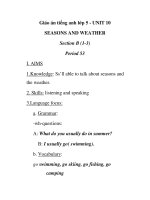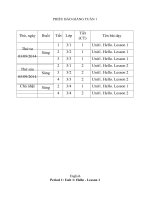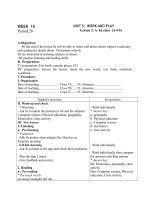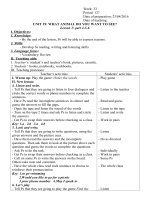GIÁO ÁN TIẾNG ANH LỚP 1 - TUẦN 10
Bạn đang xem bản rút gọn của tài liệu. Xem và tải ngay bản đầy đủ của tài liệu tại đây (125.32 KB, 6 trang )
<span class='text_page_counter'>(1)</span><div class='page_container' data-page=1>
<b>Date of preparing: 6/11/2020</b>
<b>Date of teaching: 1A – Monday, November 9, 2020 </b>
<b>Week 10 - Period: 19 </b>
<b>UNIT 3 : COLORS</b>
<b>Lesson 3 – Part A, B, C.</b>
<b>I. Objectives:</b>
By the end of this lesson, students will be able to identify the color of objects
and show gratitude.
<b>II. Teaching aids:</b>
<b>Teacher’s aids: student book and teacher’s book, class CDs, flashcards, IWB</b>
software, projector/interactive whiteboard/TV.
<b>Students’ aids: Student books, notebooks, workbooks.</b>
<b>III. Languages focus:</b>
<b>Vocabulary: pink, white, flower</b>
<b>Structures :</b>
It's a (pink) flower.
Thank you.
You're welcome.
<b>IV. Procedures:</b>
<b>Time</b> <b>Steps/Activities</b> <b>Organizatio</b>
<b>n</b>
5’ <b>Warm-up</b>
<b>Sing the alphabet song</b>
<b>Option 1: Seven lives </b>
<b>-</b> Draw or stick seven bodies outlines on the board.
<b>-</b> Give students a topic.
<b>-</b> Choose a word. Draw one line on the board for each
letter in a word, for example: _ _ _ ( red).
<b>-</b> Have students put up their hands to say a letter, if the
letter is in the word, teacher writes it on the line. If the
letter is not in the word, the teacher removes one of the
bodies from the board.
<b>-</b> When students complete the word or lose all seven
lives the game finishes.
</div>
<span class='text_page_counter'>(2)</span><div class='page_container' data-page=2>
<b>Option 2: Whisper</b>
- Arrange children into rows of at least six.
- Secretly show a flashcard to the first child in each group.
This child whispers the word to the child next to him/her.
- Children continue whispering the word to the child next to
them until the word reaches the final child.
- The final child says the word out loud, and the first child
holds up the flashcard to see whether the word is correct.
Students
work in
groups
25’ <b>New lesson</b>
<b></b>
<b> Listen and point. Repeat.</b>
CD 1- Track 45
- Arrange the flashcards on the board, play audio, and
point to each flashcard.
- Play audio again and have students point to the
pictures in their books.
- Play audio again and have students listen and repeat.
<b>Play "Guess." </b>
- Arrange the flashcards on the board and write a
number under each card.
- Have students look at the flashcards for the count of
ten. Turn the flashcards over to face the board when
the students are not looking.
- Call out a number and have students take turns to
guess the face-down card. Turn the card over after
each guess.
<b>B-1. Listen and point. </b>
CD1- Track 46
- Have students call out the things they can see.
- Have students listen and follow.
- Play audio and demonstrate pointing.
- Play audio. Have students listen and point.
<b>2. Listen and repeat.</b>
CD1- Track 47
- Have students look at the useful language box.
</div>
<span class='text_page_counter'>(3)</span><div class='page_container' data-page=3>
- Play audio. Have students listen to the useful language.
- Have students practice the useful language.
<b>C-Play "Guess the picture."</b>
- Have students look at the example.
- Divide the class into two teams.
- Have a student stand facing away from the board and
stick a flashcard on the board behind them.
- Have the student try to guess the answer without
looking at the flashcard.
- Give that team one point if it's a correct guess.
- Have teams take turns.
<b>Optional activities</b>
<b>Option 1: Musical cards </b>
- Play some lively music.
- Hand out the flashcards from this lesson.
- Children pass the flashcards around all the rows of seats
while the music is playing.
- Stop the music suddenly. Ask the children who are
holding the flashcards to stand up and say the sentence.
E.g. It’s a pink flower.
- Play the music and continue in the same way.
<b>Option 2: Draw, color and say</b>
<b>-</b> Give each student a blank sheet of paper and ask them to
draw flowers. Color these flowers.
<i><b>-</b></i> Have students work in pairs, practice saying about their
pictures.
<i>E .g. ‘It’s a pink flower.’</i>
<b>-</b> Swap the roles and continue.
Teacher-whole class/
individuals
5’
<b>Wrap-up</b>
<b>Option 1: Step away lines</b>
<b>-</b> Have students stand in two rows facing each other, so that
each student has a partner in the opposite line.
<b>-</b> Have each pair hold up their drawing pictures and say a
sentence. E g. ‘It’s a pink flower).’ Each time the pairs
complete their sentences ,both partners take a giant step
back and repeat the sentences. Every time they do so, they
</div>
<span class='text_page_counter'>(4)</span><div class='page_container' data-page=4>
will naturally need to speak louder in order to be heard by
each other.
<b>Option 2: Sentences and pictures.</b>
- Stick four picture cards on the board and write four
sentences about these pictures (E.g. ‘ It’s a red flower.’ ) in
different places.
- Have students match pictures and sentences.
- Have remain students give their ideas about their friends’
answers, then teacher gives the correct ones.
<b>***********************************</b>
<b>Date of teaching: 1A – Thursday, November 12, 2020 </b>
<b>Week 10 - Period: 20 </b>
<b>UNIT 3: COLORS</b>
<b>Lesson 3 – Part D, E</b>
<b>I. Objectives:</b>
By the end of this lesson, students will be able to identify the color of objects
and show gratitude.
<b>II. Teaching aids:</b>
<b>Teacher’s aids: student book and teacher’s book, class CDs, flashcards, IWB</b>
software, projector/interactive whiteboard/TV.
<b>Students’ aids: Student books, notebooks, workbooks.</b>
<b>III. Languages focus:</b>
<b>Vocabulary: pink, white, flower</b>
<b>Structures : </b>
It's a (pink) flower.
Thank you.
You're welcome.
<b>IV. Procedures:</b>
<b>Time</b> <b>Steps/Activities</b> <b>Organizatio</b>
<b>n</b>
5’ <b>Warm-up</b>
<b>Option 1: Run, draw and color.</b>
- Have students work in four teams.
</div>
<span class='text_page_counter'>(5)</span><div class='page_container' data-page=5>
- Stick four blank sheets on the board.
- Say “ Draw a pink flower.” Have one student of each
team run to the board to draw and color the flower.
<i>-</i> Continue the game in the same way.
<b>Option 2 : Throw the dice</b>
-Put children in pairs. Each pair has a dice with the
numbers 1–6.
-Number the sentences like the list below:
<i>1.</i> It’s a pink flower.
<i>2.</i> It’s a red flower.
<i>3.</i> It’s a yellow flower.
<i>4.</i> It’s a white flower.
<i>5.</i> 5. You get one point. Throw the dice again!
<i>6.</i> You get two points. Throw the dice again!
-Children take turns throwing the dice, read the
command and act out.
class/
individuals
Teacher-whole
class/ pair
work
25’ <b>New lesson</b>
<b>D- 1. Listen to the story.</b>
CD1- Track 48
Introduce the situation.
Have students call out the people and things they can
see.
Play audio and have students listen and read.
<b>2. Listen and repeat.</b>
CD1- Track 49
Have students look at the useful language box.
Play audio. Have students listen to the useful language.
Have students practice the useful language.
<b>E- Role-play.</b>
Divide the class into pairs.
Have students practice the dialogue.
Swap roles and repeat.
Afterwards, have some pairs demonstrate the activity
in front of the class.
<b>Optional activity:</b>
Teacher –
whole
class/
individuals
Teacher –
whole
class/
individuals
Teacher-
</div>
<span class='text_page_counter'>(6)</span><div class='page_container' data-page=6>
<b>-</b> Have students imagine some situations that they can
show gratitude.
<b>-</b> Have students work in pairs and act out these activities
in front of the class.
Teacher-
whole class/
pair work
5’
<b>Wrap-up</b>
<b>Option 1: Back to back drawing</b>
Divide the class into pairs and have them sit back to back.
Child A has picture of a flower. Child B has a
piece of paper.
Child A says: “ It’s a red flower”. Child B draw a flower
and color.
Once finished, the two children compare their pictures.
The children swap their roles.
<b>Option 2: Slap </b>
<b>-</b> Split the class into four teams.
<b>-</b> Place pictures of flowers on the board.
<b>-</b> Have four students come to the board to face off.
<i><b>-</b></i> Call out the sentence and have students run to the board
then slap the picture and repeat the sentence. The winner is
the student who slaps the picture at first.
Teacher –
whole
class/ pair
work
</div>
<!--links-->









